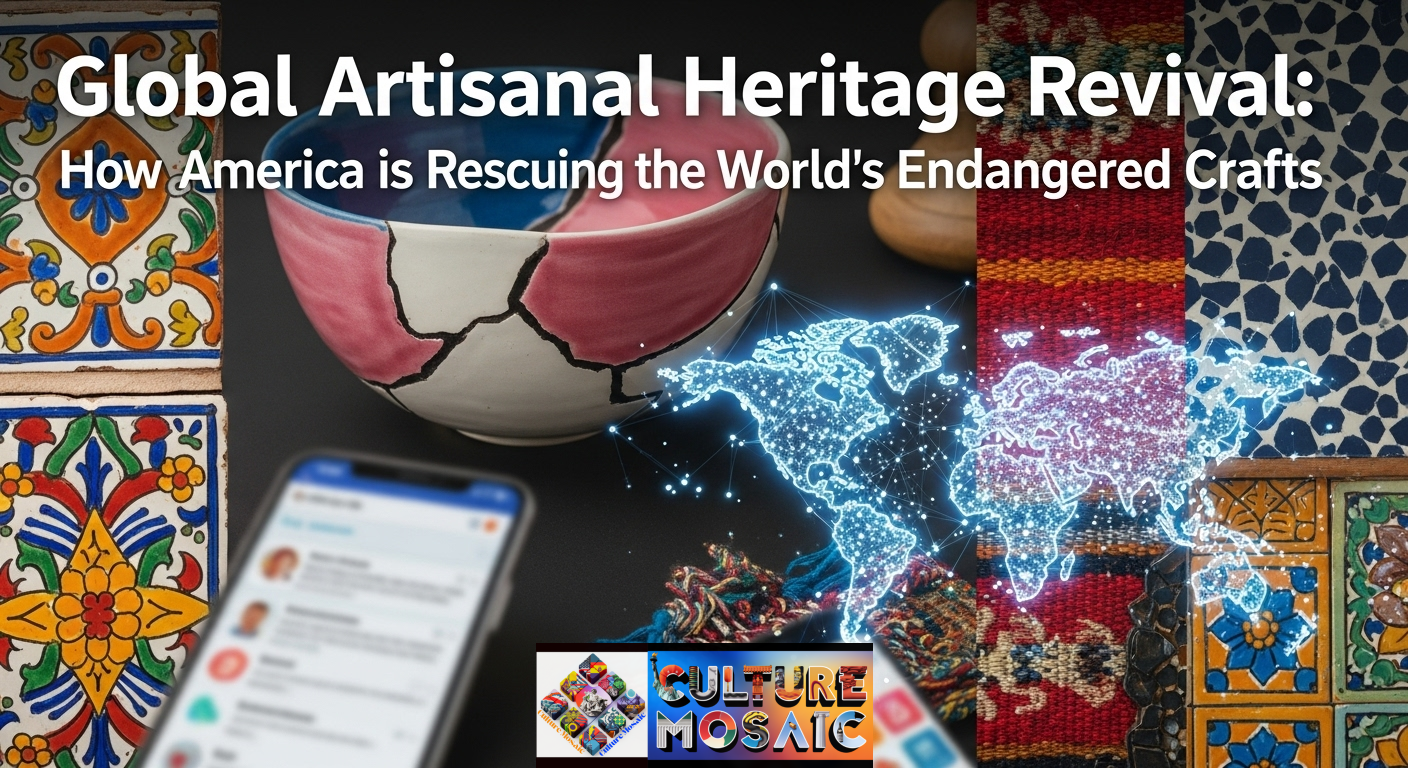Global Artisanal Heritage Revival: The ceramic bowl on your coffee table has a story. Maybe it’s the indigo patterns from a Japanese shibori artisan whose family has dyed fabric the same way for 400 years. Or the hand-hammered copper lamp from Morocco that a third-generation metalworker shaped using techniques that predate electricity. These aren’t just decorative objects. They’re survival stories.
Right now, ancient craft traditions are disappearing faster than languages. UNESCO estimates that we lose one craft every two weeks. But something unexpected is happening: the same digital forces that threatened these traditions are now saving them. And American consumers are leading the charge.
What is Global Artisanal Heritage Revival?
Global Artisanal Heritage Revival refers to the worldwide movement to preserve, restore, and economically sustain traditional craft techniques that were on the verge of extinction. It’s not about museums or archives. It’s about keeping these crafts alive as working practices by connecting artisans directly with consumers who value authenticity, sustainability, and the human story behind what they buy.
This revival depends on a simple but powerful equation: when people in developed markets like the United States purchase handmade heritage goods, they create income streams that make it financially viable for artisans to continue practicing their craft and pass it down to the next generation.
The movement gained serious momentum around 2015 when e-commerce platforms, social media storytelling, and a growing appetite for ethical consumption converged. What was once a niche interest for collectors has become a mainstream lifestyle choice for millions of Americans.
Why American Consumers are Driving the Global Artisanal Heritage Revival
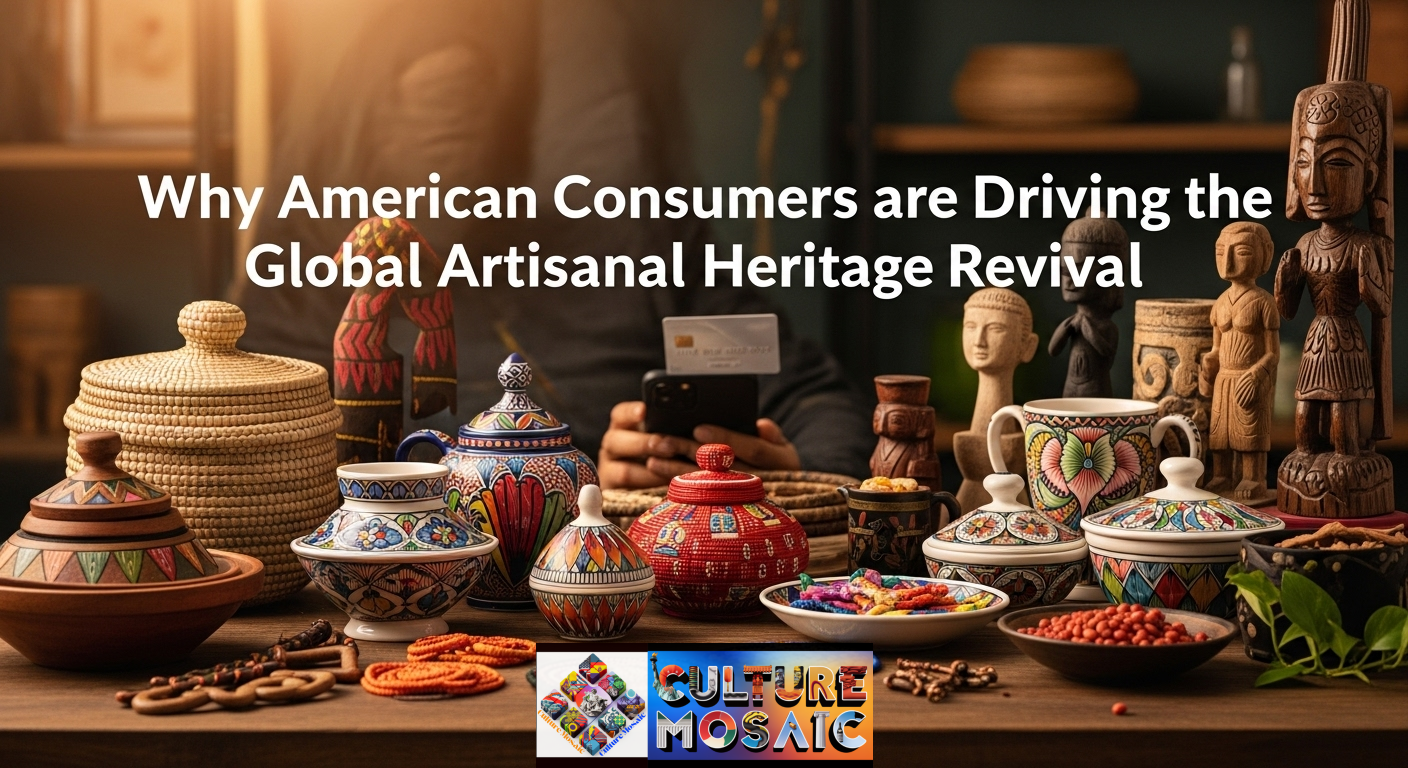
The United States has become the largest market for global artisanal goods, and it’s not hard to understand why. American spending habits have shifted dramatically in the past decade.
Millennials and Gen Z now make up the majority of consumers interested in heritage crafts. These demographics don’t just want products. They want stories, transparency, and evidence that their purchase makes a positive impact. A hand-woven basket from Rwanda isn’t competing with a mass-produced version from a big box store. It’s competing with experiences, travel, and other ways people signal their values.
The connection to sustainable living matters too. When you buy something made by hand using centuries-old techniques, you’re usually getting something that will last decades instead of seasons. That appeals to people trying to reduce waste and move away from fast fashion and disposable decor.
Americans also have more exposure to global cultures than ever before. Travel has expanded worldviews, and social media has made it possible to discover a ceramicist in Portugal or a textile artist in Guatemala without leaving your apartment. Once people see the process, the skill, and the person behind the work, they’re willing to pay premium prices.
The Technology That’s Saving Ancient Traditions
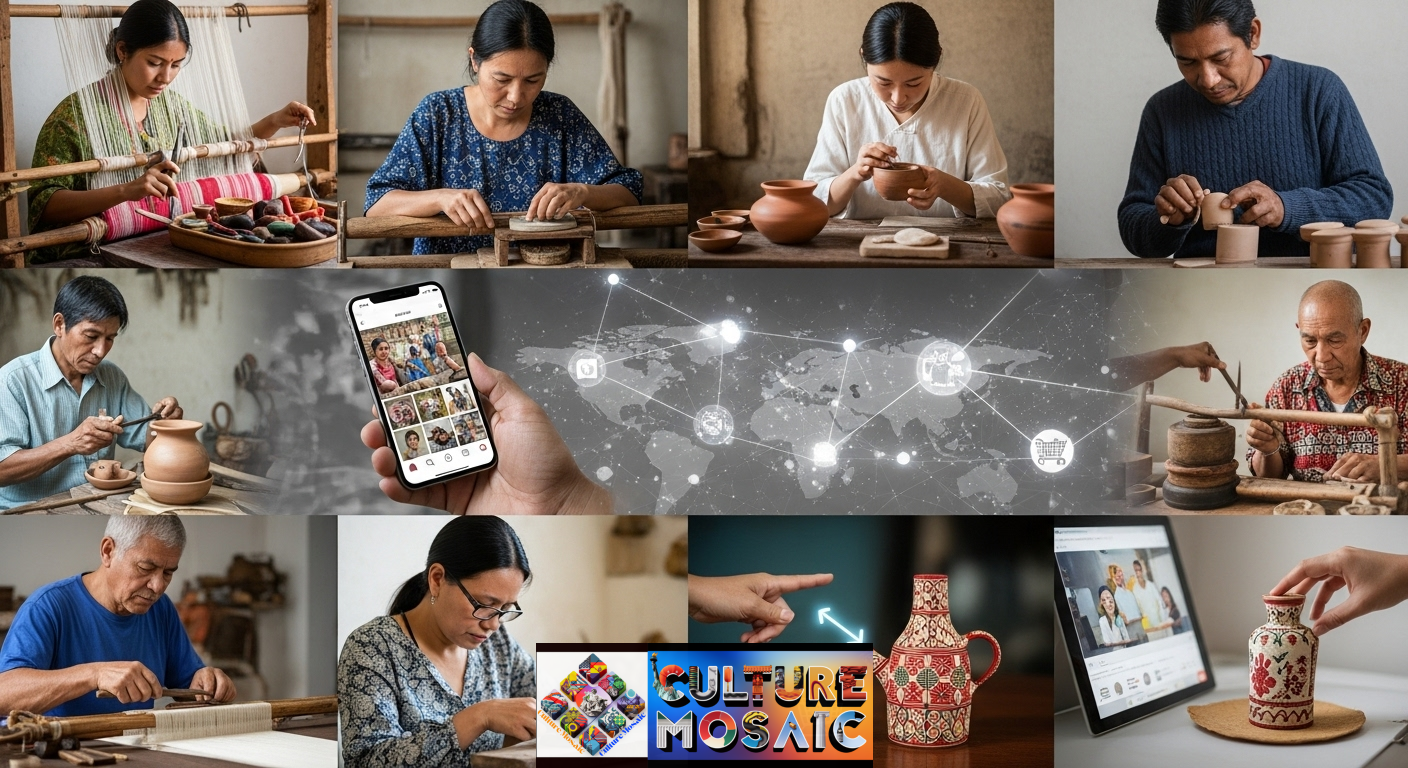
It sounds contradictory, but Instagram and Shopify are preserving craft techniques that survived for centuries without electricity. Digital tools have given artisans something they never had before: direct access to customers.
Previously, artisans depended on middlemen, export companies, or tourism. Those channels often paid exploitatively low prices and provided no connection between maker and buyer. Now, a weaver in Oaxaca can post a video showing her natural dyeing process, and someone in Brooklyn can buy directly from her shop the same day.
Platforms like Etsy, Not On The High Street, and specialized sites like Novica have built entire business models around this connection. They handle logistics and payment processing while letting artisans tell their own stories. The technology gets out of the way and lets the craft speak.
Social media storytelling has become especially powerful. Short videos showing the mesmerizing repetition of hand block printing or the transformation of raw clay into finished pottery get millions of views. People don’t just want the finished product anymore. They want to witness the process.
Some artisans have become minor celebrities. Takumi craftspeople in Japan now have international followings. Young potters in Mexico are teaching online workshops. What was once invisible labor is now valued and visible.
Case Study: Japanese Kintsugi Goes From Temple Art to Brooklyn Apartments
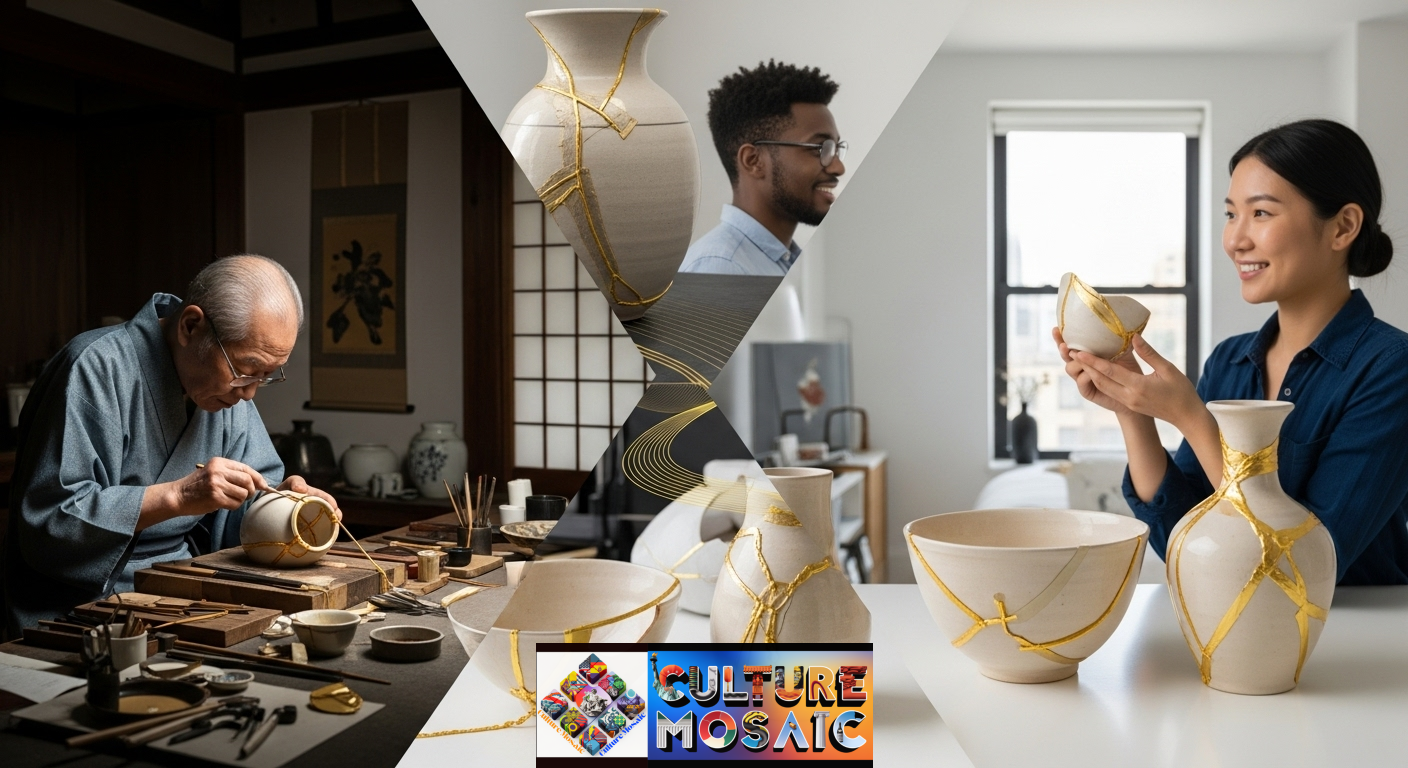
Global Artisanal Heritage Revival: Kintsugi, the Japanese art of repairing broken pottery with gold lacquer, has almost disappeared. By the 1980s, only a handful of elderly craftspeople still practiced the technique, and they had few apprentices. The process is time-intensive and requires years to master. It seemed destined for museums.
Then something shifted. The philosophy behind kintsugi resonated with Western audiences looking for alternatives to throwaway culture. Instead of hiding damage, kintsugi celebrates it. The repaired object becomes more valuable than the original.
American designers started incorporating kintsugi aesthetics into ceramics, jewelry, and even architecture. Workshops teaching simplified versions of the technique sold out in major cities. Demand for authentic kintsugi repair services exploded.
Today, young Japanese artisans are apprenticing again. The craft has an economic future because international customers understand and value its cultural significance. A bowl that would have been discarded now gets shipped across the Pacific for repair work that costs hundreds of dollars. And people are happy to pay it.
Mexican Talavera Pottery: From Colonial Legacy to Modern Commerce
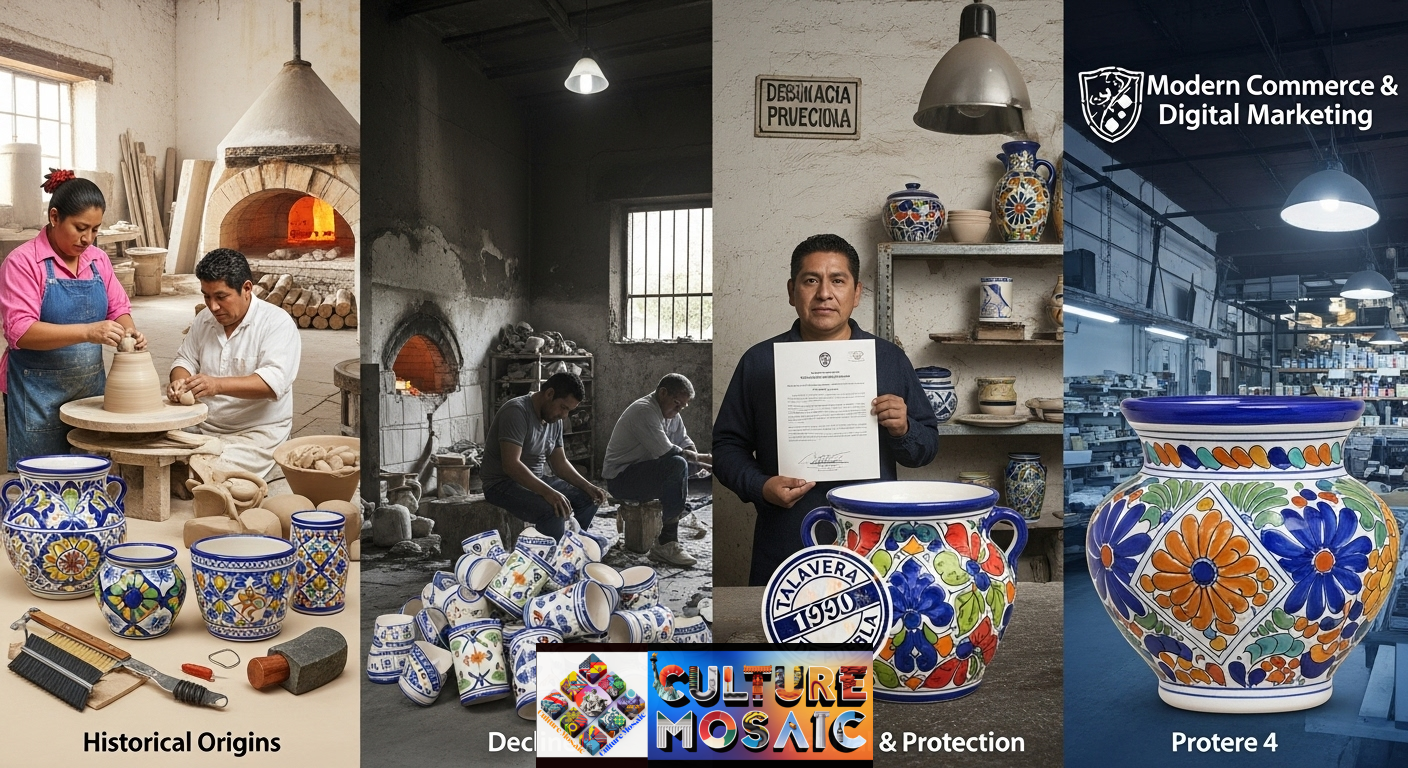
Talavera pottery from Puebla, Mexico, represents one of the most successful examples of Global Artisanal Heritage Revival. This tin-glazed ceramic tradition came to Mexico via Spanish colonizers in the 16th century, blending Indigenous and European techniques into something entirely new.
By the 1990s, cheap imports were destroying the market. Workshops that had operated for generations were closing. The knowledge was at risk of being lost.
The revival came through a combination of legal protection and digital marketing. Talavera earned a designation of origin status in 1997, meaning only pieces made in certain regions using traditional methods could carry the name. This protected authenticity and quality.
But protection alone wasn’t enough. Artisans and cooperatives started using e-commerce and social media to reach American customers directly. They shared videos of the intricate hand-painting process and the clay preparation that takes weeks. They explained why authentic Talavera costs more than mass-produced imitations.
American interior designers discovered Talavera and started featuring it in high-end projects. Home improvement shows showcased it. Pinterest boards spread images of colorful Talavera tile installations. The aesthetic hit at exactly the right moment when people were moving away from minimalist gray everything.
Now, Talavera workshops have waiting lists. Young people are entering the trade again. The craft has an economic engine that sustains it.
Indian Block Printing: Ancient Technique Meets Sustainable Fashion
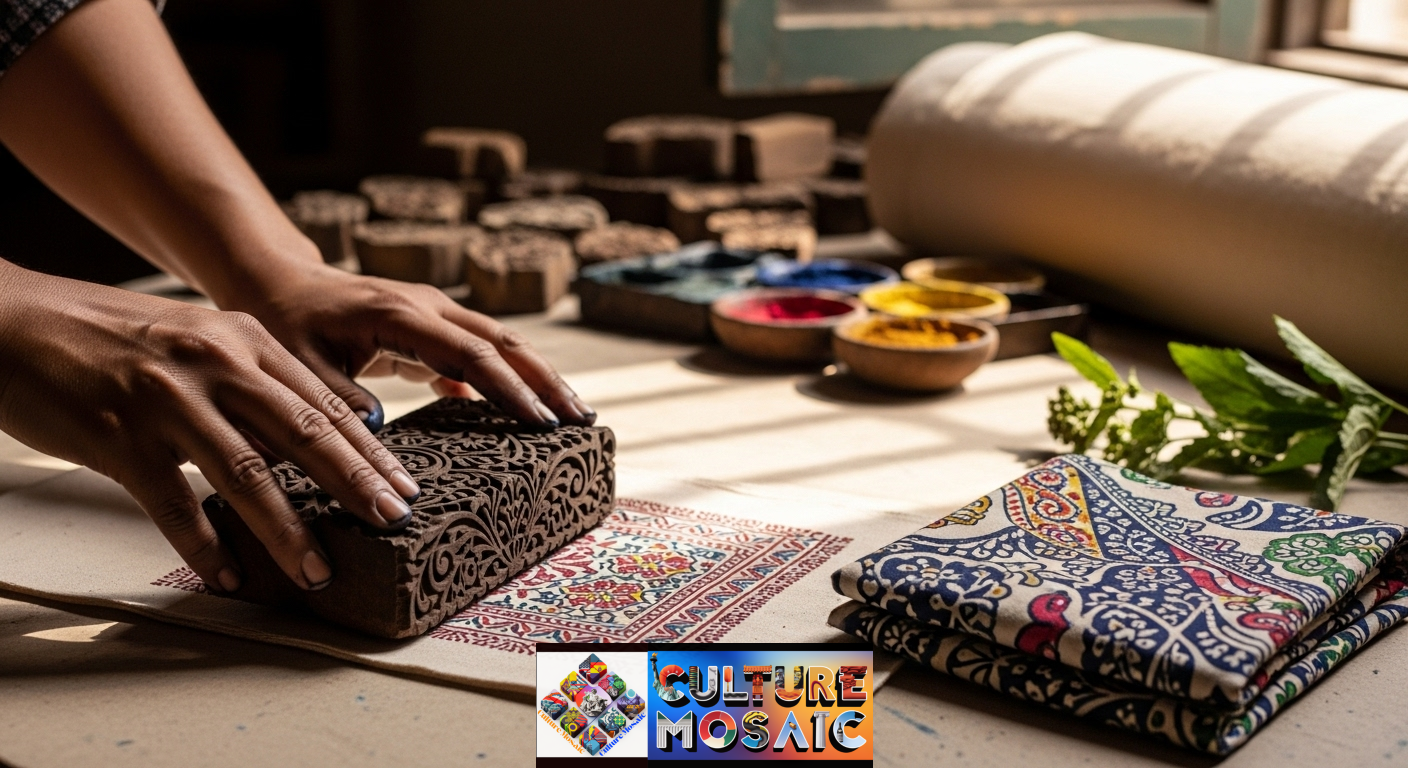
Textile block printing in Rajasthan dates back over 3,000 years. Artisans hand-carve intricate designs into wooden blocks, then stamp them repeatedly onto fabric using natural dyes. The precision and stamina required are remarkable. A single piece can require hundreds of individual impressions.
This craft nearly died in the face of industrial textile production. Why pay for days of labor when machines could print fabric in seconds? By the early 2000s, entire communities of block printers had abandoned the practice.
The Global Artisanal Heritage Revival has completely reversed this trajectory. Sustainable fashion brands discovered that consumers would pay significantly more for genuinely hand-printed fabric. The imperfections and slight variations in block printing became selling points rather than flaws.
American companies like Parachute, Boll & Branch, and smaller boutique brands now contract directly with block printing cooperatives. They market the artisan story as prominently as the products themselves. Customers can often trace their bedding or clothing back to specific workshops and even specific artisans.
This has created stable income for thousands of families. Master block printers now train apprentices. The knowledge is passing to a new generation because there’s an economic incentive to learn a difficult skill.
Some cooperatives have gotten sophisticated about their digital presence. They maintain Instagram accounts showing the daily work of printing. They offer virtual studio tours. They’ve turned transparency into a competitive advantage.
Peruvian Weaving Traditions: Connecting Mountains to Markets
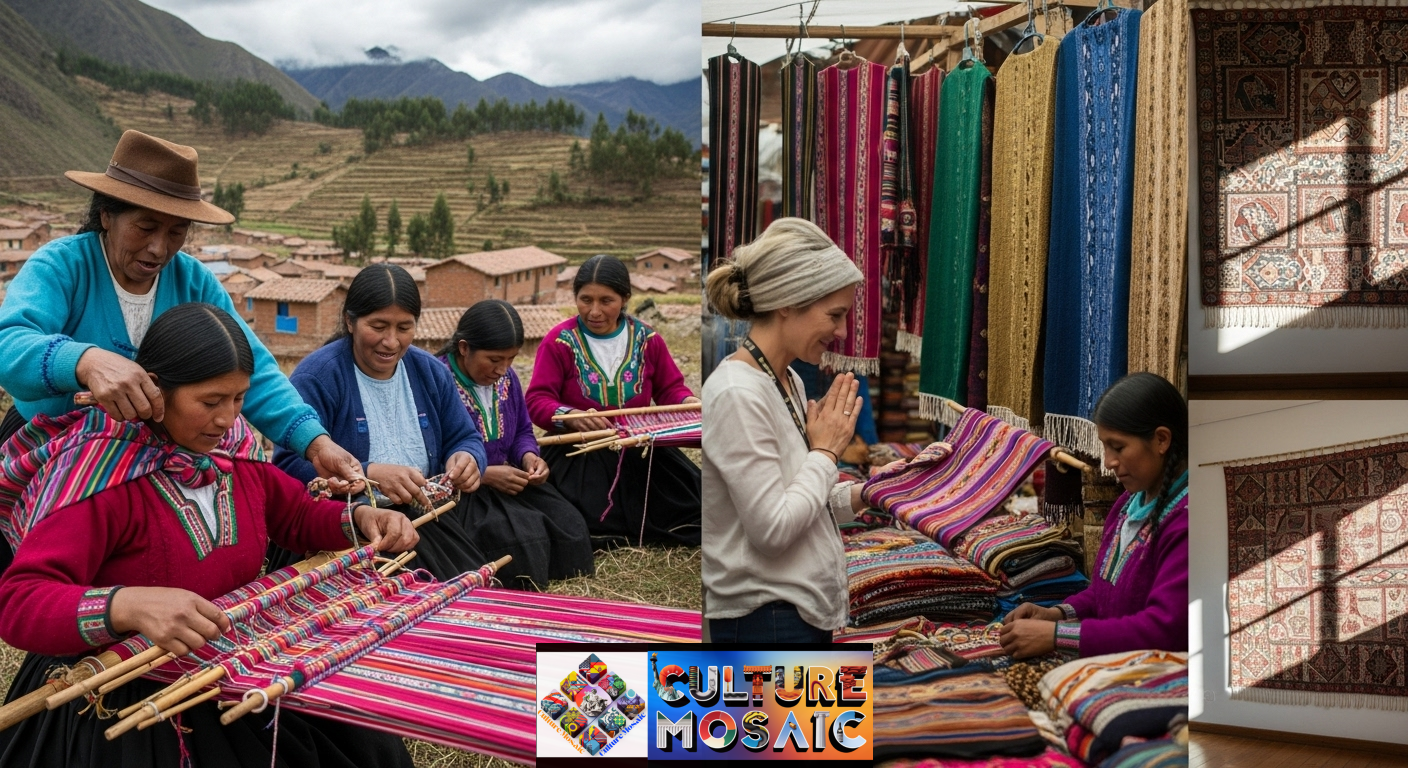
Global Artisanal Heritage Revival: In remote mountain villages across Peru, weaving traditions go back to pre-Incan civilizations. Women learn complex patterns from their mothers and grandmothers, memorizing designs that encode cultural knowledge. Each region has distinct styles, colors, and techniques.
For decades, these weavers could only sell through tourism or middlemen who paid almost nothing. Many stopped weaving because it couldn’t support a family. The younger generation moved to cities for work.
Organizations focused on Global Artisanal Heritage Revival have changed this equation. Groups like the Center for Traditional Textiles of Cusco connect weavers directly with international markets. They handle logistics and provide fair pricing while letting artisans maintain creative control.
American consumers have shown a surprising willingness to pay premium prices for authentic textiles when they understand what goes into them. A single wall hanging might represent 200 hours of work using hand-spun wool and natural dyes. When customers learn this, $500 seems reasonable rather than expensive.
The impact extends beyond economics. Older weavers who had stopped practicing have returned to their looms. Teenagers are learning patterns their communities feared would be forgotten. The craft is a living culture again rather than a historical artifact.
Some cooperatives have introduced innovations while maintaining traditional techniques. They work with designers to create patterns that appeal to contemporary aesthetics without abandoning cultural authenticity. It’s evolution rather than compromise.
Moroccan Zellige Tilework: Ancient Geometry in Modern Spaces
Zellige, the intricate mosaic tilework found throughout Morocco, requires extraordinary skill. Artisans hand-cut glazed tiles into precise geometric shapes, then assemble them into complex patterns without adhesive, relying purely on precision and experience. Master craftspeople train for decades.
This tradition faced near extinction as modern construction methods favored cheaper, faster materials. Why spend weeks on tilework when printed alternatives existed?
American architects and interior designers provided the answer. They discovered that authentic zellige added texture, depth, and craftsmanship impossible to replicate with industrial materials. Instagram helped spread images of zellige installations in boutique hotels, restaurants, and high-end homes.
The demand created by Global Artisanal Heritage Revival has brought economic stability to zellige workshops. Artisans now export internationally while also working on restoration projects in Morocco. The craft has prestige again.
Some workshops have adapted to modern markets by offering smaller, more accessible products like decorative tiles or table sets. This lets more people engage with the craft without commissioning full installations. It also provides a steadier income between large projects.
Young Moroccans are apprenticing again. A craft that seemed headed for museums is thriving as a contemporary practice.
How to Participate in Global Artisanal Heritage Revival
You don’t need to be wealthy to support traditional crafts. Start by researching the origin of items you’re considering buying. Look for transparency about who made something and how.
Choose platforms and retailers that prioritize artisan welfare. Many now provide detailed information about their supply chains and payment structures. If a company can’t tell you where something came from and who made it, that’s a red flag.
When possible, buy directly from artisans or cooperatives. This ensures more money reaches the maker. E-commerce has made this easier than ever.
Understand that authentically made heritage goods cost more because they should. If the price seems too low for something supposedly handmade, it probably isn’t. Real craftsmanship requires time and skill.
Share the stories behind what you buy. When friends compliment something in your home, tell them about the artisan who made it. This spreads awareness and creates more demand for authentic work.
Consider quality over quantity. One beautiful, well-made object you’ll use for decades is better than multiple cheap items you’ll replace repeatedly. This mindset supports both sustainability and artisan livelihoods.
Visit artisans when you travel. Buying directly from makers in their studios or workshops creates personal connections and ensures they receive full value for their work. Plus, you’ll understand the process better.
The Future of Global Artisanal Heritage Revival
This movement faces challenges. Success creates its own problems. When demand for a craft increases dramatically, quality can suffer as workshops rush production or untrained people flood the market with inferior goods.
There’s also the question of cultural appropriation versus appreciation. When Western companies or designers incorporate traditional patterns and techniques, who benefits? Done well, it can create income and recognition for artisan communities. Done poorly, it’s exploitation.
Climate change threatens many traditional practices. Natural dye plants are becoming harder to source. Weather patterns that artisans relied on for centuries are shifting. Communities may need to adapt techniques while maintaining cultural authenticity.
The digital divide remains real. Artisans in extremely remote areas or older craftspeople may lack access to the technology that’s driving this revival. Intermediary organizations play a crucial role in bridging these gaps, but they add costs and complexity.
Despite these challenges, the trajectory is positive. More people than ever understand that when they buy heritage crafts, they’re voting with their wallets for cultural preservation. They’re funding not just objects but entire knowledge systems and communities.
The next generation of artisans is increasingly hybrid. They understand traditional techniques and social media marketing. They can hand-carve wood and edit video. This combination of skills positions them to sustain their crafts long-term.
Some regions are developing craft tourism, where visitors come specifically to learn about and purchase traditional goods. This creates additional income streams while raising awareness. Done thoughtfully, it can benefit communities without turning living culture into performance.
Universities and design schools are paying more attention to traditional techniques. Some are partnering with master artisans to document processes and train students. This creates cross-cultural knowledge exchange and ensures techniques are preserved even if economic circumstances change.
Beyond Objects: What Global Artisanal Heritage Revival Really Preserves
Global Artisanal Heritage Revival: Heritage crafts aren’t just about making beautiful things. They carry knowledge about material science, sustainability, and design that predates modern industries. A natural dyer knows chemistry that pharmaceutical companies would find valuable. A basket weaver understands engineering principles that architects study.
These crafts also maintain cultural identity and continuity. When a young person learns to weave patterns their great-grandmother wove, they’re connecting across generations. They’re participating in a living tradition rather than just reading about it.
Many traditional crafts are inherently sustainable. They use local, renewable materials. They’re designed to last. They don’t require industrial infrastructure or fossil fuels. In an era of climate crisis, this indigenous knowledge about working with rather than against nature is increasingly valuable.
The skills themselves shape cognition. Hand weaving complex patterns strengthens spatial reasoning and pattern recognition. Throwing pottery develops proprioception and focus. We’re losing not just crafts but entire ways of thinking and learning.
Community structures often organize around craft traditions. Cooperatives provide social safety nets, knowledge sharing, and mutual support. When crafts disappear, these community bonds often break down too.
For many Indigenous and marginalized communities, crafts represent one of the few pathways to economic self-determination. They can generate income without requiring people to leave their homes or abandon their cultural practices. This matters for community survival.
The Economic Impact is Real
Global Artisanal Heritage Revival isn’t charity or nostalgia. It’s a functioning economic model that benefits both artisans and consumers.
Studies show that fair-trade artisan goods generate more sustainable income than many forms of international aid. The money goes directly to working families. It supports local economies rather than creating dependency.
For American consumers, heritage crafts offer value that mass-produced items can’t match. Quality, uniqueness, and meaning matter more to many people than having the cheapest option. The market has proven this repeatedly.
The sector is growing rapidly. The global handicrafts market was valued at over $700 billion in 2023 and continues expanding. Millions of people worldwide derive primary income from traditional crafts, with the United States as their largest customer base.
Some artisans have become prosperous by any standard. Master craftspeople with strong online presence can earn comfortable livings in regions where most people struggle with poverty. This creates aspirational models for younger generations.
The multiplier effect matters too. When artisans earn a good income, they spend locally. They can afford to send their children to school. They invest in their communities. One thriving craft workshop can lift an entire village economically.
Starting Your Own Collection: What to Look For
Quality heritage crafts should show evidence of hand production. Look for slight variations and imperfections that prove human involvement. Perfect uniformity usually indicates machine production.
Research typical price ranges for the craft you’re interested in. If something seems suspiciously cheap, it probably isn’t authentic. Real hard work costs money.
Verify the source when possible. Reputable sellers provide detailed information about artisans and production methods. They’re transparent about their supply chains.
Consider functionality alongside beauty. The best heritage crafts are designed to be used, not just displayed. A handwoven basket should be sturdy enough for daily use.
Start with smaller pieces if you’re new to collecting. This lets you learn about quality and authenticity without major financial commitment. As you develop understanding, you can invest in larger works.
Connect with other collectors and enthusiasts. Online communities share knowledge about authentic sources, fair pricing, and upcoming artisans to watch. This collective wisdom helps everyone make better choices.
Visit museums and cultural centers that display traditional crafts. This develops your eye for quality and authenticity. You’ll better understand what distinguishes masterwork from adequate craftsmanship.
Read about the cultural context of crafts you’re drawn to. Understanding the symbolism, history, and traditional uses deepens appreciation and helps you make informed purchases.
The Role of Education in Global Artisanal Heritage Revival
Global Artisanal Heritage Revival: Documentation is crucial for craft preservation. Organizations are creating detailed records of traditional techniques before the last generation of master artisans passes away. Video documentation is especially valuable for complex physical processes.
Some artisan communities are developing their own educational programs. They’re systematizing traditional knowledge that was previously passed informally from master to apprentice. This makes it more accessible to learners.
Western institutions are starting to recognize traditional craft knowledge as equivalent to academic expertise. Some universities now offer courses taught by master artisans, validating their knowledge in formal educational contexts.
Online learning platforms have made craft education globally accessible. An aspiring potter in Ohio can take classes from a master in Japan. This cross-cultural exchange benefits everyone involved.
Apprenticeship programs are being revitalized with modern support structures. Some include stipends so young people can afford to learn instead of taking immediately paying work. This addresses the main barrier to craft transmission.
Cultural festivals and exhibitions bring traditional crafts to wider audiences. When people see demonstrations and meet artisans, they develop a deeper appreciation. This creates both customers and advocates.
School programs in artisan communities sometimes incorporate traditional crafts into the curriculum. This ensures children gain basic familiarity even if they don’t pursue crafts professionally. It maintains cultural knowledge across society rather than isolating it to specialists.
Frequently Asked Questions About Global Artisanal Heritage Revival
What does Global Artisanal Heritage Revival mean?
Global Artisanal Heritage Revival is the worldwide movement to preserve and economically sustain traditional craft techniques that are disappearing. It connects artisans directly with consumers who value handmade, authentic goods, creating income that makes these ancient practices viable for new generations to continue.
How can I support traditional artisans?
Support artisans by buying directly from them or through ethical platforms that ensure fair payment. Research products before purchasing to verify authenticity. Choose quality over quantity and share the stories behind what you buy to raise awareness. When traveling, visit workshops and purchase directly from makers.
Why are heritage crafts more expensive than mass-produced items?
Heritage crafts cost more because they require significant time, skill, and often hand-processed materials. A single piece might represent hundreds of hours of work by someone who trained for years or decades. You’re paying for genuine craftsmanship, cultural knowledge, and quality that will last generations.
Which countries benefit most from the artisanal heritage revival?
Countries across Latin America, Asia, Africa, and parts of Europe benefit significantly. Mexico, Peru, India, Morocco, Japan, and Guatemala have particularly strong artisan traditions that American consumers support. However, every region with traditional crafts can participate when connected to ethical markets.
Is buying heritage crafts actually helping preserve traditions?
Yes, when done through legitimate channels. Economic sustainability is essential for craft preservation. When artisans can earn a good living, they continue practicing their crafts and teaching the next generation. Without a viable income, even deeply passionate craftspeople often must abandon traditional work for economic survival.

